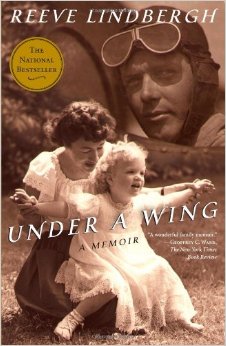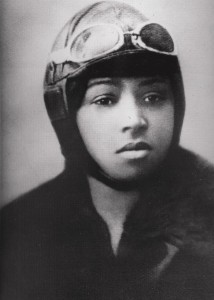Sky High
2014
 For National Aviation Day, we are delighted to share this note from RIF friend Reeve Lindbergh, author and daughter of aviator Charles Lindbergh.
For National Aviation Day, we are delighted to share this note from RIF friend Reeve Lindbergh, author and daughter of aviator Charles Lindbergh.
Nobody Owns the Sky:
How the Book Came to Be
By Reeve Lindbergh
Some time when I was growing up, I’m not exactly sure when, I learned that my father, Charles Lindbergh, was an American hero. In 1927, almost twenty years before I was born, he had flown alone in a small airplane called the Spirit of St. Louis across the Atlantic Ocean from New York to Paris, something that had never been done before. The flight took him just over 33 hours and made him world-famous at the age of twenty-five.
Newspaper reporters followed him everywhere he went, by himself or later when he was with my mother. She became a pilot too, and served as his co-pilot and navigator on flights they made together to survey early airline routes all over the world.
My father thought that he had become too famous. He was glad that he’d made the flight to Paris and he wanted people to believe in aviation, which was very new in those days, but he didn’t like being followed or treated like a celebrity. He and my mother wanted to have a normal life so they could raise their five children: me and my sister and our three brothers. Our parents found a quiet place to live in Connecticut and worked very hard to keep our daily lives free of reporters and media attention.
 They did such a good job that I did not fully understand how famous my father was until I grew up and left home. Then I discovered that there were museums with Lindbergh exhibits all over this country, including the Smithsonian National Air and Space Museum in Washington D.C., where you can see both the Spirit of St. Louis and the Lockheed Sirius seaplane my parents flew together on the survey flights.
They did such a good job that I did not fully understand how famous my father was until I grew up and left home. Then I discovered that there were museums with Lindbergh exhibits all over this country, including the Smithsonian National Air and Space Museum in Washington D.C., where you can see both the Spirit of St. Louis and the Lockheed Sirius seaplane my parents flew together on the survey flights.
By the time my father died in 1974 I had grown up and started my own family. I missed my father, and in 1977 I attended celebrations honoring the 50th anniversary of his famous flight to Paris. Ten years later there were celebrations for the 60th anniversary, but I had a newborn baby and needed to stay home with my family.
While I was at home during that time I saw a PBS documentary film about flying, produced by Philip A. Hart. His great-uncle, Herman Banning, had been a pioneer aviator. The film was called Flyers in Search of a Dream, and it was about a group of pilots who flew at the same time my mother and father did in the 1920’s and 1930’s. They were just as brave and skilled and adventurous as my parents, but they didn’t receive as much attention. They were pioneer black aviators. At that time in history most black Americans were badly treated and their achievements neglected. It seemed to me that if my parents got too much attention for their pioneer aviation adventures, the black pilots definitely got too little. I wanted to learn more.
Of all the aviation pioneers in Philip Hart’s film, Bessie Coleman interested me the most. Maybe it was because she was beautiful, or because she was lively and independent and eager to learn. I think, though, it was because she didn’t let anything stand in the way of her dreams. Everything was against her when she was growing up: she was poor, she was black, and she was a woman. Women of any race could not even vote in the United States until 1920, and for a black woman to become a pilot was out of the question. Everywhere she went asking to learn to fly, she was told “No!” But Bessie Coleman did not take “no” for an answer.
While she was working as a manicurist in Chicago, Bessie learned that she might be able to learn to fly in France, where there was much less racial bias than in the United States. With the help of friends in Chicago she sailed across the Atlantic Ocean to France in 1921. She studied flying at a French flying school and received her international pilot’s license there, becoming the first licensed black pilot in the world.
 Bessie wanted other people, especially other young black people, to learn about flying. She traveled in Europe and throughout the United States, giving lectures and performing in air shows and exhibitions. Crowds began to gather whenever she appeared. She had followed her dreams and she was teaching others to do the same. Then, tragically, in April of 1926, while she was flying over a field in Jacksonville, Florida with another pilot the day before an exhibition, Bessie’s plane had a mechanical failure, went into a nosedive and crashed, killing both pilots.
Bessie wanted other people, especially other young black people, to learn about flying. She traveled in Europe and throughout the United States, giving lectures and performing in air shows and exhibitions. Crowds began to gather whenever she appeared. She had followed her dreams and she was teaching others to do the same. Then, tragically, in April of 1926, while she was flying over a field in Jacksonville, Florida with another pilot the day before an exhibition, Bessie’s plane had a mechanical failure, went into a nosedive and crashed, killing both pilots.
More than 5000 people attended Bessie Coleman’s funeral service in Jacksonville. Another 10,000 people filed past her coffin to pay their respects in Chicago, where she was laid to rest.
One year later my father, a young man from the Midwest who had just spent several years flying the U.S. Mail from Chicago to St. Louis, flew the Spirit of St. Louis from New York to Paris and into the pages of history books.
After I watched Flyers in Search of a Dream I wanted to celebrate the story of Bessie Coleman and the other black aviators. I wanted to honor the courage they showed, first by challenging racial barriers and overcoming obstacles my parents never had to face, and then by going on to join the company of pioneering American aviators.
When I started to write my own book about Bessie Coleman, I found that her story came to me as a rhyme. Later the rhyme became a book. This is how it begins:
There was a young woman who wanted to fly,
But the people said, “Kiss that wish good bye!
The sky’s too big and the sky’s too high,
And you never will fly, so you’d better not try.”
But this woman laughed, and she just said, “Why?
Nobody owns the sky!”
More children’s books by Reeve Lindbergh include:
- Our Nest
- On Morning Wings
- The Circle of Days
- What Is The Sun?
- If I’d Known Then What I Know Now
- There’s a COW in the Road!
- Grandfather’s Lovesong
- The Midnight Farm
- Benjamin’s Barn
- The Day The Goose Got Loose


Follow Us